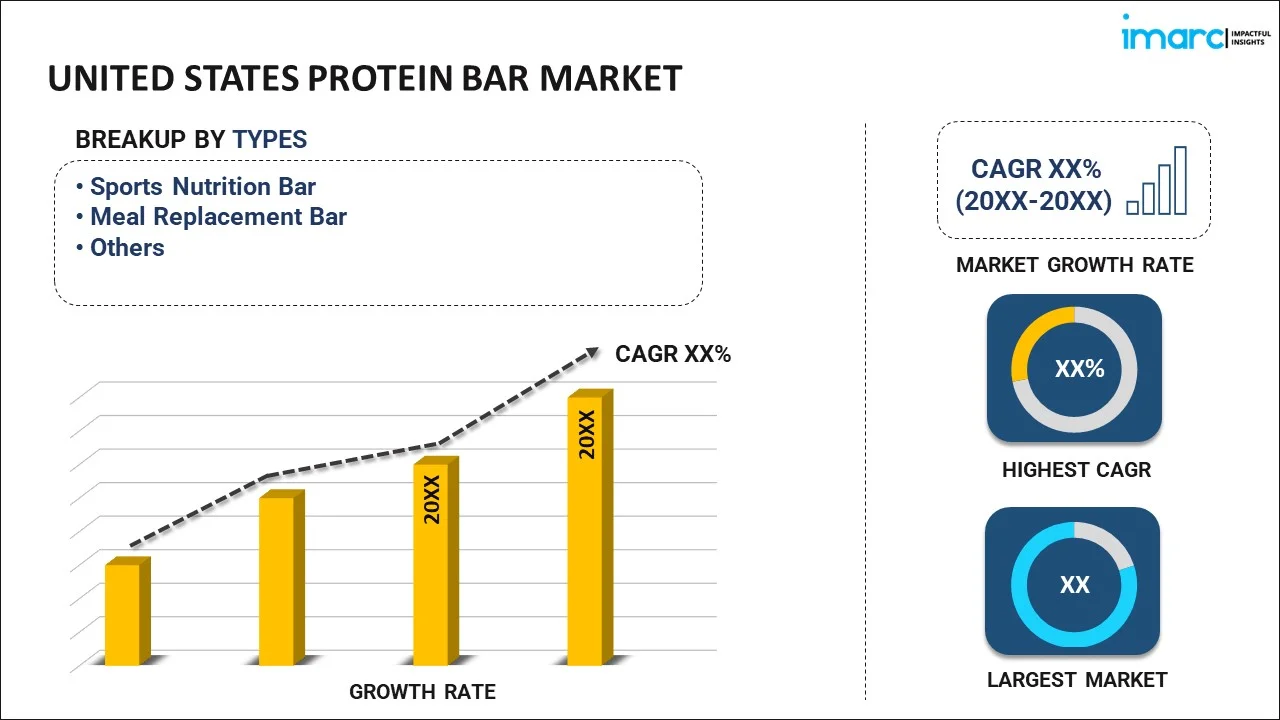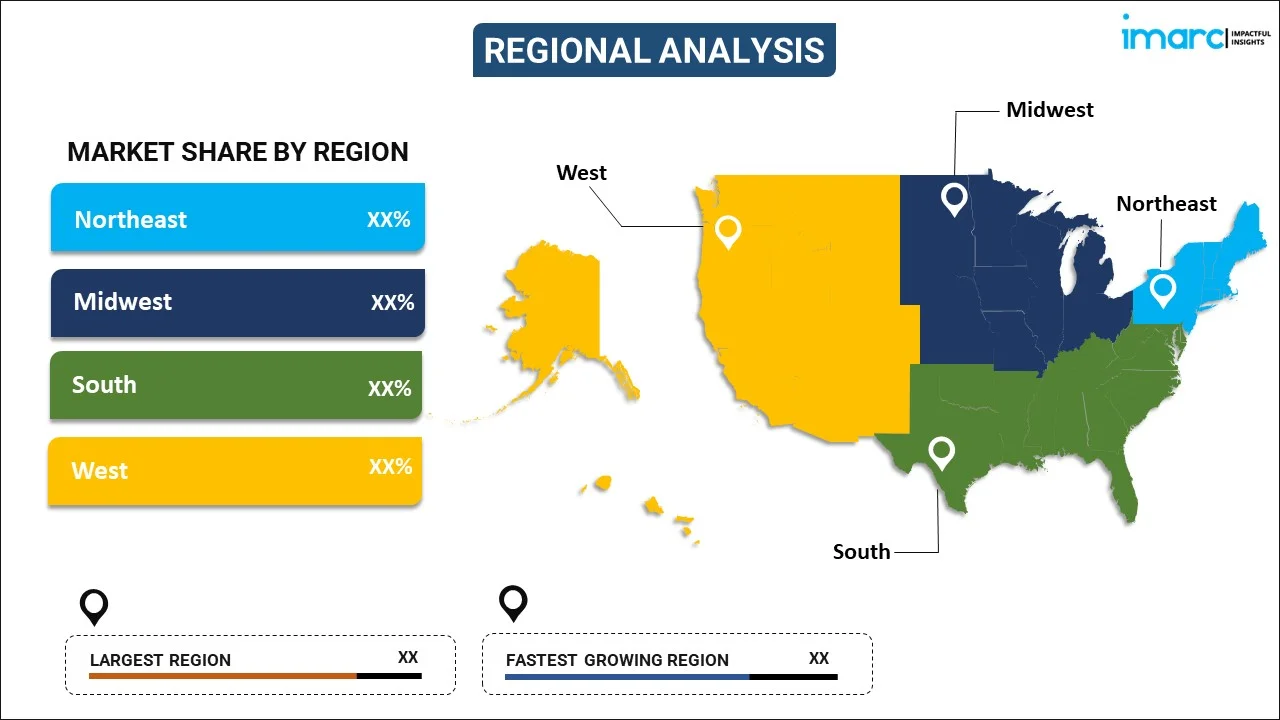
United States Protein Bar Market Report by Type (Sports Nutrition Bar, Meal Replacement Bar, and Others), Source (Plant-Based, Animal-Based), Distribution Channel (Supermarkets and Hypermarket, Convenience Stores, Specialty Stores, Online Stores, and Others), and Region 2024-2032
Market Overview:
United States protein bar market size is projected to exhibit a growth rate (CAGR) of 5.74% during 2024-2032. The increasing availability of protein bars in various retail outlets and the growth of e-commerce platforms that have increased accessibility for consumers, is driving the market.
|
Report Attribute
|
Key Statistics
|
|---|---|
|
Base Year
|
2023 |
|
Forecast Years
|
2024-2032
|
|
Historical Years
|
2018-2023
|
| Market Growth Rate (2024-2032) | 5.74% |
A protein bar is a convenient and portable food product designed to supplement protein intake. Typically composed of various protein sources such as whey, soy, or pea protein, these bars serve as a quick and accessible way for individuals to meet their protein requirements, especially for those engaged in fitness and active lifestyles. Protein bars often contain a balanced combination of macronutrients, including carbohydrates and fats, making them a convenient on-the-go snack or meal replacement. The protein content supports muscle repair and growth, making them popular among athletes, fitness enthusiasts, and individuals aiming to increase their protein intake. With a variety of flavors and formulations available, protein bars cater to different dietary preferences and requirements. However, it's essential to read labels carefully, considering factors like sugar content and additives, to ensure the nutritional alignment with individual health and fitness goals.
United States Protein Bar Market Trends:
The protein bar market in the United States has experienced exponential growth in recent years, primarily driven by the escalating demand for convenient and nutritious on-the-go snacks. Consumers, increasingly health-conscious, are seeking protein-rich alternatives to traditional snacks, propelling the market forward. Moreover, the rising awareness of the importance of protein in supporting muscle development, weight management, and overall well-being has significantly contributed to the surge in protein bar consumption. Additionally, the fitness and wellness trend has played a pivotal role in steering the protein bar market, as individuals engaged in regular physical activity often incorporate these bars into their dietary regimen. Furthermore, the widespread adoption of healthier lifestyles and dietary preferences, including low-carb and high-protein diets, has fueled the market's expansion. The protein bar market has also benefitted from advancements in flavor profiles and ingredient innovations, catering to diverse consumer tastes and preferences. In conclusion, a confluence of factors, ranging from health consciousness to lifestyle choices and taste preferences, has created a robust demand for protein bars, positioning the market as a dynamic and rapidly evolving segment within the broader snack industry. As these trends persist and evolve, the protein bar market in the United States is poised for sustained growth in the foreseeable future.
United States Protein Bar Market Segmentation:
IMARC Group provides an analysis of the key trends in each segment of the market, along with forecasts at the country level for 2024-2032. Our report has categorized the market based on type, source, and distribution channel.
Type Insights:

- Sports Nutrition Bar
- Meal Replacement Bar
- Others
The report has provided a detailed breakup and analysis of the market based on the type. This includes sports nutrition bar, meal replacement bar, and others.
Source Insights:
- Plant-Based
- Animal-Based
A detailed breakup and analysis of the market based on the source have also been provided in the report. This includes plant-based and animal-based.
Distribution Channel Insights:
- Supermarkets and Hypermarkets
- Convenience Stores
- Specialty Stores
- Online Stores
- Others
The report has provided a detailed breakup and analysis of the market based on the distribution channel. This includes supermarkets and hypermarkets, convenience stores, specialty stores, online stores, and others.
Regional Insights:

- Northeast
- Midwest
- South
- West
The report has also provided a comprehensive analysis of all the major regional markets, which include Northeast, Midwest, South, and West.
Competitive Landscape:
The market research report has also provided a comprehensive analysis of the competitive landscape in the market. Competitive analysis such as market structure, key player positioning, top winning strategies, competitive dashboard, and company evaluation quadrant has been covered in the report. Also, detailed profiles of all major companies have been provided.
United States Protein Bar Market Report Coverage:
| Report Features | Details |
|---|---|
| Base Year of the Analysis | 2023 |
| Historical Period | 2018-2023 |
| Forecast Period | 2024-2032 |
| Units | US$ Million |
| Scope of the Report | Exploration of Historical and Forecast Trends, Industry Catalysts and Challenges, Segment-Wise Historical and Predictive Market Assessment:
|
| Types Covered | Sports Nutrition Bar, Meal Replacement Bar, Others |
| Sources Covered | Plant-Based, Animal-Based |
| Distribution Channels Covered | Supermarkets and Hypermarket, Convenience Stores, Specialty Stores, Online Stores, Others |
| Regions Covered | Northeast, Midwest, South, West |
| Customization Scope | 10% Free Customization |
| Report Price and Purchase Option | Single User License: US$ 3699 Five User License: US$ 4699 Corporate License: US$ 5699 |
| Post-Sale Analyst Support | 10-12 Weeks |
| Delivery Format | PDF and Excel through Email (We can also provide the editable version of the report in PPT/Word format on special request) |
Key Questions Answered in This Report:
- How has the United States protein bar market performed so far and how will it perform in the coming years?
- What has been the impact of COVID-19 on the United States protein bar market?
- What is the breakup of the United States protein bar market on the basis of type?
- What is the breakup of the United States protein bar market on the basis of source?
- What is the breakup of the United States protein bar market on the basis of distribution channel?
- What are the various stages in the value chain of the United States protein bar market?
- What are the key driving factors and challenges in the United States protein bar?
- What is the structure of the United States protein bar market and who are the key players?
- What is the degree of competition in the United States protein bar market?
Key Benefits for Stakeholders:
- IMARC’s industry report offers a comprehensive quantitative analysis of various market segments, historical and current market trends, market forecasts, and dynamics of the United States protein bar market from 2018-2032.
- The research report provides the latest information on the market drivers, challenges, and opportunities in the United States protein bar market.
- Porter's five forces analysis assist stakeholders in assessing the impact of new entrants, competitive rivalry, supplier power, buyer power, and the threat of substitution. It helps stakeholders to analyze the level of competition within the United States protein bar industry and its attractiveness.
- Competitive landscape allows stakeholders to understand their competitive environment and provides an insight into the current positions of key players in the market.
Need more help?
- Speak to our experienced analysts for insights on the current market scenarios.
- Include additional segments and countries to customize the report as per your requirement.
- Gain an unparalleled competitive advantage in your domain by understanding how to utilize the report and positively impacting your operations and revenue.
- For further assistance, please connect with our analysts.
 Inquire Before Buying
Inquire Before Buying
 Speak to an Analyst
Speak to an Analyst
 Request Brochure
Request Brochure
 Request Customization
Request Customization




.webp)




.webp)












